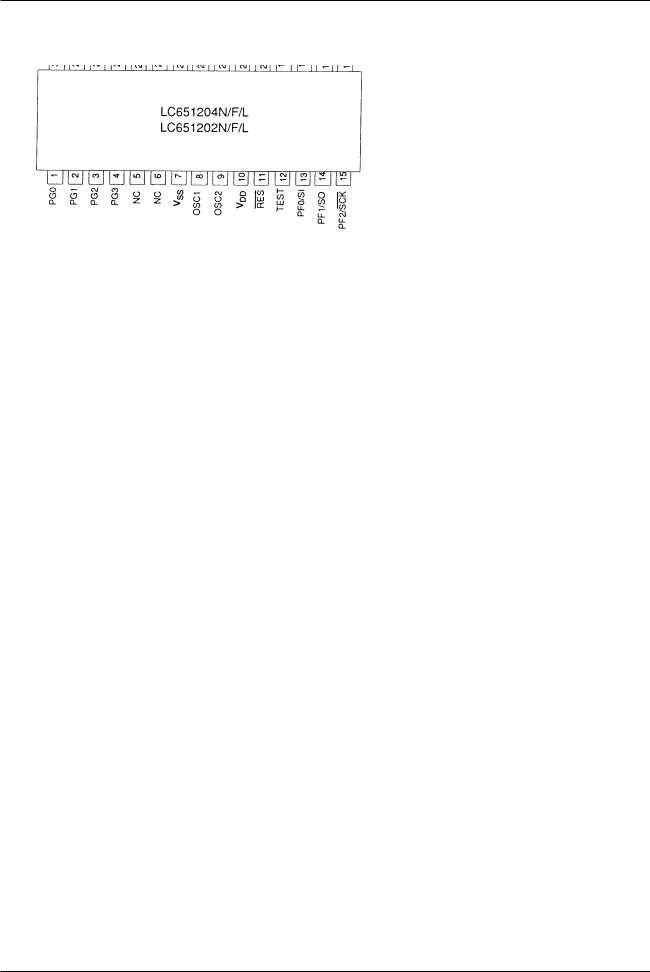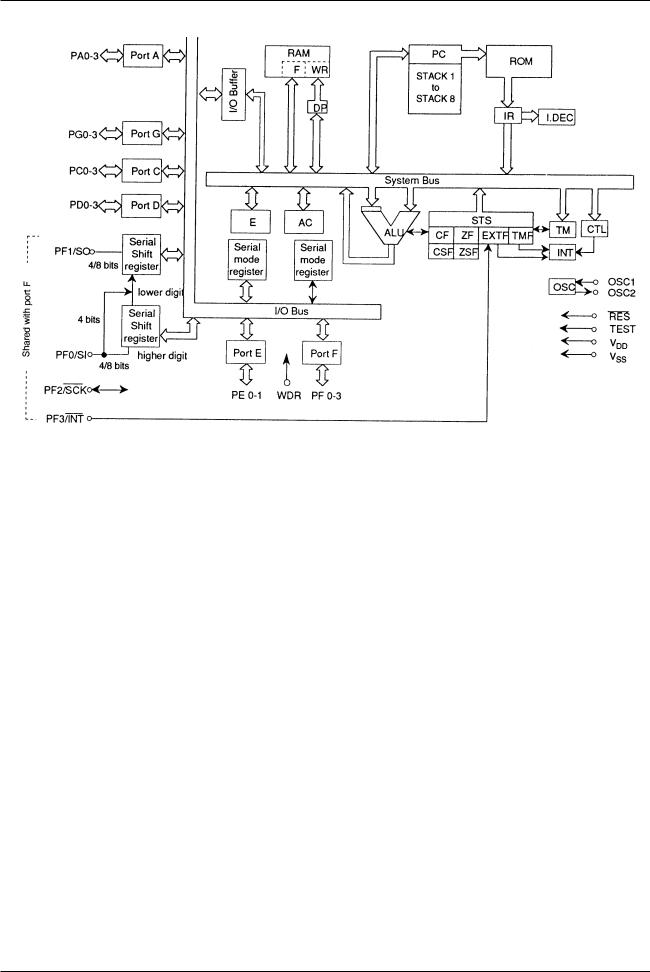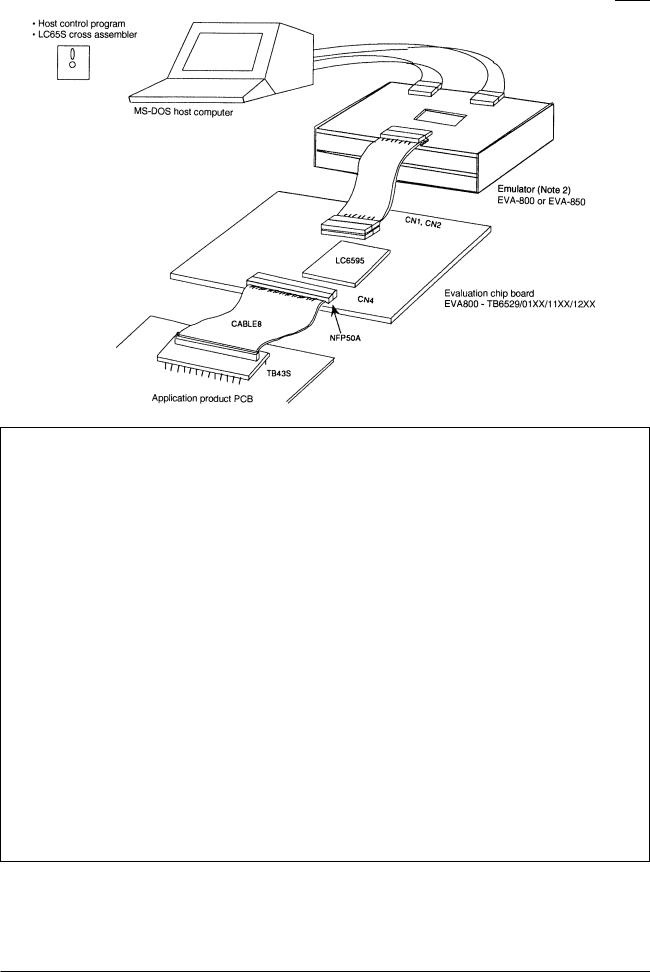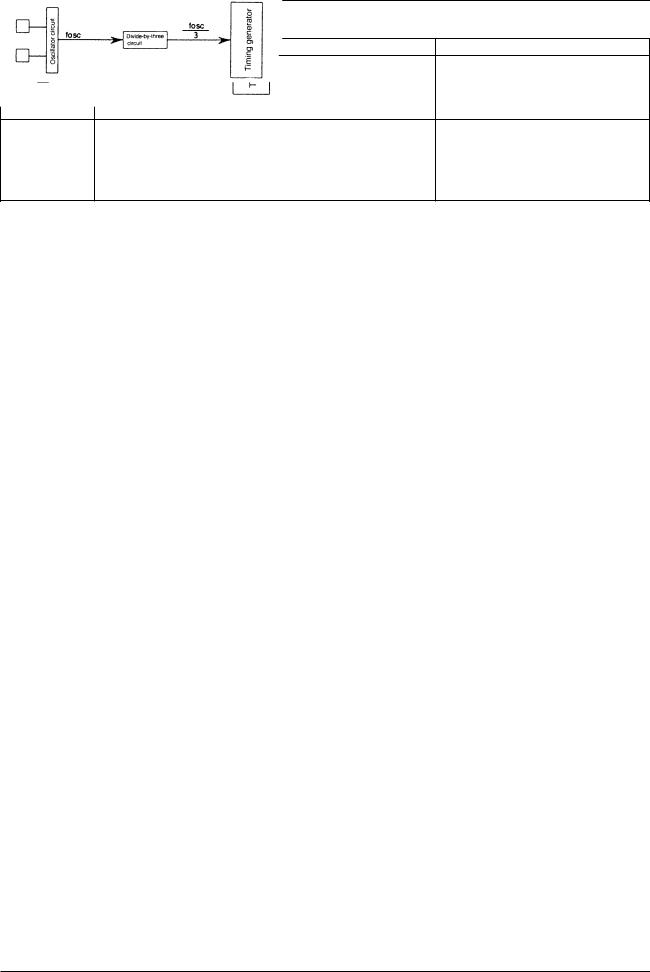SANYO LC651204L, LC651204F, LC651202N, LC651202L, LC651202F Datasheet
...
Ordering number : EN*5190
CMOS LSI
LC651204N/F/L, LC651202N/F/L
4-Bit Single-Chip Microcontrollers for Small-Scale Control Applications
Preliminary
Overview
The LC651204N/F/L and LC651202N/F/L are small-scale application microcontroller products in Sanyo's LC6500 series of 4-bit single-chip CMOS microcontrollers, and as such they fully support the basic architecture and instruction set of that series. These microcontrollers are provided in a 30-pin package and include 2 kilobytes (KB) and 4 KB of on-chip ROM. These products are appropriate for use in a wide range of applications, from applications that use a small number of controls and circuits that were previously implemented in standard logic to larger scale applications including audio equipment such as decks and players, office equipment, communications equipment, automotive equipment, and home appliances. Except for the lack of an A/D converter, these microcontrollers provide the same functionality as the LC651104, 02N/F/L.
Features
•Fabricated in a CMOS process for low power (An instruction-controlled standby function is provided.)
•ROM/RAM
LC651204N/F/L - ROM: 4K × 8 bits, RAM: 256 × 4 bits LC651202N/F/L - ROM: 2K × 8 bits, RAM: 256 × 4 bits
•Instruction set: The 80-instruction set provided by all members of the LC6500 series.
•Wide operating power-supply voltage range of 2.5 to 5.5 volts (L version)
•Instruction cycle time: 0.92 µs (F version)
•On-chip serial I/O circuit
•Highly flexible I/O ports
—Number of ports: 6 ports with a total of 22 pins
—All ports: Can be used for both input and output
I/O voltage: 15 V maximum (Only for C, D, E, and F ports with opendrain output specifications)
Output current: 20 mA maximum sink current (Capable of directly driving LEDs.)
—Options that allow specifications to be customized to match those of the application system.
Specification of open-drain output or built-in pullup resistor: can be specified for all ports in bit units.
Specification of the output level at reset: Can be specified to be high or low for ports C and D in port units.
•Interrupt functions
—Timer overflow vector interrupt (The interrupt state can be tested by the CPU.)
—Vector interrupts initiated by the INT pin or full/empty states of the serial I/O circuit. (The interrupt state can be tested by the CPU.)
•Stack levels: 8 levels (shared with interrupts)
•Timers: 4-bit prescaler plus 8-bit programmable timers
•Clock oscillator options to match application system specifications.
—Oscillator circuit options: 2-pin ceramic oscillator (N, F, and L versions)
—Divider circuit option: No divider, built-in divide-by- three circuit, built-in divide-by-four circuit (N and L versions)
•Supports continuous output of a square wave signal (with a period 64 times the cycle time)
•Watchdog timer
—RC time constant scheme
—A watchdog timer function can be allocated to one of the external pins as an option.
•EP version: LC65E1104, OTP version: LC65P1104
SANYO Electric Co.,Ltd. Semiconductor Bussiness Headquarters
TOKYO OFFICE Tokyo Bldg., 1-10, 1 Chome, Ueno, Taito-ku, TOKYO, 110 JAPAN
93096HA (OT) No. 5190-1/35

LC651204N/F/L, LC651202N/F/L
Package Dimensions |
|
|
unit : mm |
unit : mm |
|
3196-DIP30SD |
3073A-MFP30S |
|
|
|
|
[LC651204N/F/L, 651202N/F/L] |
|
[LC651204N/F/L, 651202N/F/L] |
SANYO: DIP30SD |
SANYO: MFP30S |
Note: The package drawings shown above are provided without error tolerances and are for reference purposes only. Contact Sanyo for official package drawings.
Function Overview
|
Item |
LC651204N/1202N |
LC651204F/1202F |
LC651204L/1202L |
|
|
|
|
|
|
|
|
ROM |
4096 × 8 bits (1204N) |
4096 × 8 bits (1204F) |
4096 × 8 bits (1204L) |
|
|
|
|
|
||
Memory |
2048 × 8 bits (1202N) |
2048 × 8 bits (1202F) |
2048 × 8 bits (1202L) |
||
|
|||||
|
|
|
|
|
|
|
RAM |
256 × 4 bits (1204/1202N) |
256 × 4 bits (1204/1202F) |
256 × 4 bits (1204/1202L) |
|
|
|
|
|
|
|
Instruction |
Instruction set |
80 |
80 |
80 |
|
|
|
|
|
||
Table reference |
Supported |
Supported |
Supported |
||
|
|||||
|
|
|
|
|
|
|
Interrupts |
1 external, 1 internal |
1 external, 1 internal |
1 external, 1 internal |
|
|
|
|
|
|
|
|
Timers |
4-bit prescaler + 8-bit timer |
4-bit prescaler + 8-bit timer |
4-bit prescaler + 8-bit timer |
|
|
|
|
|
|
|
Built-in functions |
Stack levels |
8 |
8 |
8 |
|
|
|
|
|
|
|
|
Standby function |
Supports standby mode entered |
Supports standby mode entered |
Supports standby mode entered |
|
|
by the HALT instruction |
by the HALT instruction |
by the HALT instruction |
||
|
|
||||
|
|
|
|
|
|
|
Number of ports |
22 I/O pins |
22 I/O pins |
22 I/O pins |
|
|
|
|
|
|
|
|
Serial ports |
4-bit or 8-bit I/O |
4-bit or 8-bit I/O |
4-bit or 8-bit I/O |
|
|
|
|
|
|
|
|
I/O voltage |
15 V max. |
15 V max. |
15 V max. |
|
|
|
|
|
|
|
I/O ports |
Output current |
10 mA typ. 20 mA max. |
10 mA typ. 20 mA max. |
10 mA typ. 20 mA max. |
|
|
|
|
|
|
|
|
I/O circuit types |
Open drain (n-channel) or built-in pull-up resistor output selectable on a per-bit basis. |
|||
|
|
|
|
||
|
Output levels at reset |
High or low can be selected in port units. (ports C and D only) |
|
||
|
|
|
|
|
|
|
Square wave output |
Supported |
Supported |
Supported |
|
|
|
|
|
|
|
|
Minimum cycle time |
2.77 µs (VDD ≥ 3 V) |
0.92 µs (VDD ≥ 3 V) |
3.84 µs (VDD ≥ 2.5 V) |
|
Characteristics |
Power-supply voltage |
3 to 5.5 V |
3 to 5.5 V |
2.5 to 5.5 V |
|
|
|
|
|
|
|
|
Power-supply current |
1.5 mA typ. |
2 mA typ. |
1.5 mA typ. |
|
|
|
|
|
|
|
Oscillator |
Oscillator |
Ceramic (800 kHz, 1 MHz, 4 MHz) |
Ceramic (4 MHz) |
Ceramic (800 kHz, 1 MHz, 4 MHz) |
|
|
|
|
|
||
Divider circuit option |
1/1, 1/3, 1/4 |
1/1 |
1/1, 1/3, 1/4 |
||
|
|||||
|
|
|
|
|
|
Other functions |
Package |
DIP30S-D MFP30S |
DIP30S-D MFP30S |
DIP30S-D MFP30S |
|
|
|
|
|
|
|
Note: Sanyo will announce details on oscillator elements and oscillator circuit constants as recommended application circuits are developed. Customers should check with Sanyo for the latest information as the development process progresses.
No. 5190-2/35

LC651204N/F/L, LC651202N/F/L
Pin Assignment
Common assignments for the DIP and MFP packages
Note: NC pins must be connected Top view
Pin Functions
|
|
|
Pin |
|
|
|
|
Function |
|
|
|
||||||
|
OSC1, OSC2 |
Connections for a ceramic oscillator element |
||||||
|
|
|
|
|
|
|
|
|
|
|
|
|
|
|
|
|
|
|
RES |
Reset |
||||||
|
|
|
||||||
|
PA0 to 3 |
I/O dual-function port A0 to A3 |
||||||
|
|
|
||||||
|
PC0 to 3 |
I/O dual-function port C0 to C3 |
||||||
|
|
|
||||||
|
PD0 to 3 |
I/O dual-function port D0 to D3 |
||||||
|
|
|
||||||
|
PE0 to 1 |
I/O dual-function port E0 to E1 |
||||||
|
|
|
||||||
|
PF0 to 3 |
I/O dual-function port F0 to F3 |
||||||
|
|
|
||||||
|
PG0 to 3 |
I/O dual-function port G0 to G3 |
||||||
|
|
|
||||||
|
TEST |
Test |
||||||
|
|
|
|
|
|
|
|
|
|
|
|
|
Interrupt request |
||||
|
INT |
|
|
|||||
|
|
|
||||||
|
SI |
Serial input |
||||||
|
|
|
||||||
|
SO |
Serial output |
||||||
|
|
|
|
|
|
|
||
|
|
|
|
|
|
|
|
|
|
SCK |
Serial clock input and output |
||||||
|
|
|
||||||
|
NC |
No connection |
||||||
|
|
|
||||||
|
WDR |
Watchdog reset |
||||||
|
|
|
|
|
|
|
|
|
|
|
|
|
|
|
|
|
|
Note: The SI, SO, SCK, and INT pins are shared function pins that are also used as PF0 to PF3.
No. 5190-3/35

LC651204N/F/L, LC651202N/F/L
System Block Diagram
RAM: |
Data memory |
ROM: |
Program memory |
F: |
Flag |
PC: |
Program counter |
WR: |
Working register |
INT: |
Interrupt control |
AC: |
Accumulator |
IR: |
Instruction register |
ALU: |
Arithmetic and logic unit |
I.DEC: |
Instruction decoder |
DP: |
Data pointer |
CF, CSF: |
Carry flag, carry save flag |
E: |
E register |
ZF, ZSF: |
Zero flag, zero save flag |
CTL: |
Control register |
EXTF: |
External interrupt request flag |
OSC: |
Oscillator circuit |
TMF: |
Internal interrupt request flag |
TM: |
Timer |
|
|
STS: |
Status register |
|
|
No. 5190-4/35

LC651204N/F/L, LC651202N/F/L
Development Support
Sanyo provides the following items to support application development using the LC651204 and LC651202.
1.User’s manual
The “LC651104/1102 User’s Manual” is used with these microcontrollers.
2.Development tool manual
See the “EVA800 - LC651104/1102 Development Tool Manual” for details on use of the EVA-800 system.
3.Development tool
•Program development (using the EVA-800 system)
—MS-DOS host computer system *1
—Cross assembler ... MS-DOS-based cross assembler: LC65S.EXE
—Evaluation chip: LC6595
—Emulator: The EVA-800 main unit plus the evaluation chip
•Program development (using the EVA-86000 system): Use the EVA86K-ECB651100.
•Program evaluation
The <LC65E1104> on-chip EPROM microcontroller
Development Support System
EVA-800 System
Note: 1. MS-DOS is a registered trademark of Microsoft Corporation
2.Here, “EVA-800” is a generic term for several emulators. Suffixes (A, B, etc.) will be attached to the name as new versionsare developed. Note that the EVA-800 emulator (i.e., the model with no suffix) is an old version and cannot be used.
No. 5190-5/35

LC651204N/F/L, LC651202N/F/L
Pin Functions
Pin |
Pin no. |
I/O |
|
Function |
Options |
State at reset |
Handling when unused |
|
|
|
|
|
|
|
|
VDD |
1 |
— |
Power supply |
— |
— |
— |
|
VSS |
1 |
— |
|
|
|
|
|
|
|
|
• |
System clock oscillator |
(1) External clock |
— |
— |
OSC1 |
1 |
Input |
|
Connect an external ceramic oscillator |
(2) Two-pin ceramic oscillator |
|
|
|
|
|
|
element to these pins |
(3) Divider circuit option |
|
|
|
|
|
|
|
|
|
|
|
|
|
• Leave OSC2 open if an external clock |
1. No divider circuit |
|
|
|
|
|
|
|
is supplied. |
|
|
|
OSC2 |
1 |
Output |
|
2. Divide-by-three circuit |
|
|
|
|
|
|
|
||||
|
|
|
|
|
3. Divide-by-four circuit |
|
|
|
|
|
|
|
|
|
|
|
|
|
• |
I/O port A0 to A3 |
(1) Output open drain |
High-level output |
Open drain output select |
|
|
|
|
Input in 4-bit units using the IP |
(2) Built-in pull-up resistor |
(i.e., the output |
the options, connect to |
|
|
|
|
n-channel |
VSS. |
||
|
|
|
|
instruction |
• Options (1) and (2) can be |
||
|
|
|
|
|
transistor will be |
|
|
|
|
|
|
Output in 4-bit units using the OP |
specified in bit units. |
|
|
|
|
|
|
off.) |
|
||
|
|
|
|
instruction |
|
|
|
|
|
|
|
|
|
|
|
|
|
|
|
Port bits can be tested in bit units using |
|
|
|
|
|
|
|
the BP and BNP instructions. |
|
|
|
PA0 to |
4 |
I/O |
|
Port bits can be set or cleared in bit |
|
|
|
PA3 |
|
|
|
|
|
|
|
|
|
|
units using the SPB and RPB |
|
|
|
|
|
|
|
|
|
|
|
|
|
|
|
|
instructions. |
|
|
|
|
|
|
• |
PA3 is used for standby control. |
|
|
|
|
|
|
• |
Applications must be designed so that |
|
|
|
|
|
|
|
no chattering (e.g. switch bounce) |
|
|
|
|
|
|
|
occurs on the PA3 pin during a HALT |
|
|
|
|
|
|
|
instruction execution cycle. |
|
|
|
|
|
|
|
|
|
|
|
|
|
|
• I/O port C0 to C3 |
(1) Output open drain |
• High-level |
The same as PA0 to |
|
|
|
|
|
The PC0 to PC3 pin functions are |
(2) Built-in pull-up resistor |
output |
PA3. |
|
|
|
|
• Low-level |
|
||
|
|
|
|
identical to those of the PA0 to 3 pins.* |
(3) High-level output at reset |
|
|
|
|
|
• |
High or low can be specified as the |
(4) Low-level output at reset |
output |
|
PC0 to |
4 |
I/O |
|
|
|||
|
output at reset as an option. |
(Depending on |
|
||||
PC3 |
|
• Options (1) and (2) can be |
|
||||
|
|
|
Note: These pins do not have a |
the option |
|
||
|
|
|
|
|
|||
|
|
|
|
specified in bit units. |
specified.) |
|
|
|
|
|
|
standby control function. |
|
||
|
|
|
|
• Option (3) and (4) are |
|
|
|
|
|
|
|
|
|
|
|
|
|
|
|
|
specified in 4-bit units. |
|
|
|
|
|
|
|
|
|
|
|
|
|
• I/O port D0 to D3 |
The same as PC0 to PC3. |
The same as |
The same as PA0 to |
|
PD0 to |
4 |
I/O |
|
The PD0 to PD3 pin functions and |
|
PC0 to PC3. |
PA3. |
|
|
|
|
||||
PD3 |
|
options are identical to those of the |
|
|
|
||
|
|
|
|
|
|
||
|
|
|
|
PC0 to PC3 pins. |
|
|
|
|
|
|
|
|
|
|
|
|
|
|
|
|
|
|
Continued on next page. |
No. 5190-6/35

LC651204N/F/L, LC651202N/F/L
Continued from preceding page.
|
Pin |
Pin no. |
I/O |
|
|
|
|
Function |
Options |
State at reset |
Handling when unused |
|||||||||
|
|
|
|
|
|
|
|
|
|
|
|
|
|
|
|
|
|
|
||
|
|
|
|
|
|
|
|
• I/O port E0 to E1 |
(1) Output open drain |
High-level output |
The same as PA0 to |
|||||||||
|
|
|
|
|
|
|
|
|
Input in 4-bit units using the IP |
(2) Built-in pull-up resistor |
(i.e., the output |
PA3. |
||||||||
|
|
|
|
|
|
|
|
|
n-channel |
|
||||||||||
|
|
|
|
|
|
|
|
|
instruction |
• Options (1) and (2) can be |
|
|||||||||
|
|
|
|
|
|
|
|
|
transistor will be |
|
||||||||||
|
|
|
|
|
|
|
|
|
|
|
|
|
|
|
|
|||||
|
|
|
|
|
|
|
|
|
Output in 4-bit units using the OP |
specified in bit units. |
|
|||||||||
|
|
|
|
|
|
|
|
|
off.) |
|
||||||||||
|
|
|
|
|
|
|
|
|
instruction |
|
|
|||||||||
|
|
|
|
|
|
|
|
|
(3) Normal port PE1 |
|
|
|
|
|||||||
|
|
|
|
|
|
|
|
|
|
|
|
|
|
|
|
|
|
|
||
|
|
|
|
|
|
|
|
|
Port bits can be set or cleared in bit |
(4) Watchdog timer reset WDR |
|
|
|
|
||||||
|
|
|
|
|
|
|
|
|
units using the SPB and RPB |
|
|
|
|
|||||||
|
|
|
|
|
|
|
|
|
(5) (3) or (4) can be specified. |
|
|
|
|
|||||||
|
|
|
|
|
|
|
|
|
instructions. |
|
|
|
|
|||||||
PE0 to |
|
|
|
|
|
|
|
|
||||||||||||
2 |
I/O |
|
Port bits can be tested in bit units using |
|
|
|
|
|
||||||||||||
PE1 |
|
|
|
|
|
|
||||||||||||||
|
|
|
the BP and BNP instructions. |
|
|
|
|
|
||||||||||||
/WDR |
|
|
|
|
|
|
|
|
||||||||||||
|
|
|
|
|
|
|
|
|
|
|
|
|
|
|||||||
|
|
|
|
|
|
|
|
• The PE0 pin also has a continuous |
|
|
|
|
|
|||||||
|
|
|
|
|
|
|
|
|
pulse (64·Tcyc) output function. |
|
|
|
|
|
||||||
|
|
|
|
|
|
|
|
• The PE1 pin can be set to function as |
|
|
|
|
|
|||||||
|
|
|
|
|
|
|
|
|
the WDR watchdog timer reset pin as |
|
|
|
|
|
||||||
|
|
|
|
|
|
|
|
|
an option. |
|
|
|
|
|
||||||
|
|
|
|
|
|
|
|
|
|
|
|
|
|
|
|
|
|
|
||
|
|
|
|
|
|
|
|
• I/O port F0 to F3 |
The same as PA0 to PA3. |
The same as |
The same as PA0 to |
|||||||||
|
|
|
|
|
|
|
|
|
This port has the same functions and |
|
PA0 to PA3. |
PA3. |
||||||||
|
|
|
|
|
|
|
|
|
|
|
|
|
|
|||||||
|
|
|
|
|
|
|
|
|
options as PE0 to PE1. * |
|
The serial port |
|
||||||||
|
|
|
|
|
|
|
|
• The pins PF0 to PF3 are also used as |
|
function is |
|
|||||||||
|
|
|
|
|
|
|
|
|
disabled. |
|
||||||||||
|
|
|
|
|
|
|
|
|
|
|
|
|
|
|
|
|
||||
|
|
|
|
|
|
|
|
|
the serial interface and the INT pin. |
|
|
|||||||||
|
|
|
|
|
|
|
|
|
|
|
|
|
|
|||||||
|
|
|
|
|
|
|
|
|
The function used can be selected |
|
The interrupt |
|
||||||||
PF0/SI |
|
|
|
|
|
|
|
|
||||||||||||
|
|
|
|
source is INT. |
|
|||||||||||||||
|
|
|
under program control. |
|
|
|||||||||||||||
|
|
|
|
|
|
|
|
|
|
|
|
|
|
|||||||
PF1/SO |
4 |
I/O |
|
|
SI ······Serial input port |
|
|
|
|
|
||||||||||
|
|
|
|
|
|
|
|
|
|
|
|
|
||||||||
PF2/SCK |
|
|
SO·····Serial output port |
|
|
|
|
|
||||||||||||
|
|
|
|
|
|
|
|
|
||||||||||||
|
|
|
|
|
|
|
|
|
|
|
|
|
|
|
||||||
PF3/INT |
|
|
|
|
|
|
|
|
|
|
|
|
|
|
|
|
||||
|
|
|
|
|
|
SCK ··Serial clock input or output |
|
|
|
|
|
|||||||||
|
|
|
|
|
|
|
|
|
|
|
|
|
|
|
||||||
|
|
|
|
|
|
|
|
|
|
|
|
|
|
|
|
|
|
|
||
|
|
|
|
|
|
|
|
|
|
INT····Interrupt request input |
|
|
|
|
|
|||||
|
|
|
|
|
|
|
|
|
Serial I/O can be switched between 4- |
|
|
|
|
|
||||||
|
|
|
|
|
|
|
|
|
bit and 8-bit operation under program |
|
|
|
|
|
||||||
|
|
|
|
|
|
|
|
|
control. |
|
|
|
|
|
||||||
|
|
|
|
|
|
|
|
|
Note: This port does not provide a |
|
|
|
|
|
||||||
|
|
|
|
|
|
|
|
|
|
continuous pulse output function. |
|
|
|
|
|
|||||
|
|
|
|
|
|
|
|
|
|
|
|
|
|
|
|
|
|
|
||
|
|
|
|
|
|
|
|
• I/O port G0 to G3 |
The same as PA0 to PA3. |
The same as |
The same as PA0 to |
|||||||||
|
|
|
|
|
|
|
|
|
This port has the same functions and |
|
PA0 to PA3. |
PA3. |
||||||||
PG0 to |
|
|
|
|
|
|
|
|
||||||||||||
4 |
I/O |
|
options as PE0 to PE1. * |
|
|
|
|
|
||||||||||||
PG3 |
|
|
|
|
|
|
||||||||||||||
|
|
|
|
|
|
|
|
|
|
|
|
|||||||||
|
|
|
Note: This port does not provide a |
|
|
|
|
|
||||||||||||
|
|
|
|
|
|
|
|
|
|
|
|
|
|
|||||||
|
|
|
|
|
|
|
|
|
|
continuous pulse output function. |
|
|
|
|
|
|||||
|
|
|
|
|
|
|
|
|
|
|
|
|
|
|
|
|
|
|
||
NC |
2 |
|
• NC pin. This pin must be connected to |
— |
— |
Connect to VSS. |
||||||||||||||
|
|
VSS in the EP and OTP versions. |
|
|||||||||||||||||
|
|
|
|
|
|
|
|
|
|
|
|
|
|
|||||||
|
|
|
|
|
|
|
|
• |
System reset input |
|
|
|
|
|
||||||
|
|
|
|
|
|
|
|
• |
Connect an external capacitor for the |
|
|
|
|
|
||||||
|
|
|
|
|
|
|
|
|
power up reset. |
— |
|
|
|
— |
||||||
RES |
1 |
Input |
|
— |
||||||||||||||||
• |
A low level must be applied for at least |
|||||||||||||||||||
|
|
|
|
|
|
|
|
|
|
|
|
|
||||||||
|
|
|
|
|
|
|
|
|
four clock cycles for the reset startup |
|
|
|
|
|
||||||
|
|
|
|
|
|
|
|
|
sequence to operate correctly. |
|
|
|
|
|
||||||
|
|
|
|
|
|
|
|
|
|
|
|
|
|
|
|
|
|
|
|
|
TEST |
1 |
Input |
• |
LSI test pin |
— |
— |
Must be connected to |
|||||||||||||
|
Must be connected to VSS. |
VSS. |
||||||||||||||||||
|
|
|
|
|
|
|
|
|
|
|
||||||||||
No. 5190-7/35

LC651204N/F/L, LC651202N/F/L
Oscillator Circuit Options
Option |
Circuit |
Conditions and notes |
The OSC2 pin must be left open.
External clock
Ceramic oscillator
Divider Options
Option |
Circuit |
Conditions and notes |
|
|
|
|
|
• Supports both oscillator options. |
|
|
• The oscillator frequency or the external clock |
|
|
frequency must not exceed 1444 kHz |
|
|
(LC651204N and LC651202N) |
No divider (1/1) |
|
• The oscillator frequency or the external clock |
|
|
frequency must not exceed 4330 kHz |
|
|
(LC651204F and LC651202F) |
|
|
• The oscillator frequency or the external clock |
|
|
frequency must not exceed 1040 kHz |
|
|
(LC651204L and LC651202L) |
|
|
|
|
|
• Supports both oscillator options. |
|
|
• The oscillator frequency or the external clock |
|
|
frequency must not exceed 4330 kHz |
Built-in divide-by-three circuit |
|
|
|
|
|
|
|
• Supports both oscillator options. |
|
|
• The oscillator frequency or the external clock |
|
|
frequency must not exceed 4330 kHz |
Built-in divide-by-four circuit |
|
|
|
|
|
Caution: The oscillator and divider options are summarized in the following tables. The information presented in those tables is crucial when using these products.
No. 5190-8/35

LC651204N/F/L, LC651202N/F/L
Divider Options for the LC651204N/1202N, LC651204F/1202F, and LC651204L/1202L LC651204N, LC651202N
Circuit type |
Frequency |
Divider option (cycle time) |
VDD range |
Notes |
|
|
800 kHz |
1/1 (5 µs) |
3 to 5.5 V |
|
|
|
|
|
|
|
|
Ceramic oscillator |
1 MHz |
1/1 (4µs) |
3 to 5.5 V |
|
|
|
|
|
|
||
4 MHz |
1/3 (3µs) |
3 to 5.5 V |
This frequency cannot be used with the 1/1 |
||
|
|||||
|
1/4 (4µs) |
3 to 5.5 V |
divider (i.e., no divider circuit) option. |
||
|
|
||||
|
|
|
|
|
|
External clock generated by a |
670 k to 1444 kHz |
1/1 (6 to 2.77 µs) |
3 to 5.5 V |
|
|
2000 k to 4330 kHz |
1/3 (6 to 2.77 µs) |
3 to 5.5 V |
|
||
two-terminal RC oscillator circuit |
|
||||
2600 k to 4330 kHz |
1/4 (6 to 3.70 µs) |
3 to 5.5 V |
|
||
|
|
||||
|
|
|
|
|
|
Use of an external clock with the |
Driving the circuit with an external clock is not possible. To use external clock drive, specify the two-terminal RC |
||||
ceramic oscillator option selected |
oscillator option. |
|
|
|
|
LC651204F, LC651202F
Circuit type |
Frequency |
Divider option (cycle time) |
VDD range |
Notes |
Ceramic oscillator |
4 MHz |
1/1 (1 µs) |
3 to 5.5 V |
|
|
|
|
|
|
External clock generated by a |
670 k to 4330 kHz |
1/1 (6 to 0.92 µs) |
3 to 5.5 V |
|
two-terminal RC oscillator circuit |
|
|||
|
|
|
|
|
|
|
|
|
|
Use of an external clock with the |
Driving the circuit with an external clock is not possible. To use external clock drive, specify the two-terminal RC |
|||
ceramic oscillator circuit |
oscillator option. |
|
|
|
|
|
|
|
|
LC651204L LC651202L
Circuit type |
Frequency |
Divider option (cycle time) |
VDD range |
Notes |
|
|
800 kHz |
1/1 (5 µs) |
2.5 to 5.5 V |
|
|
|
|
|
|
|
|
Ceramic oscillator |
1 MHz |
1/1 (4µs) |
2.5 to 5.5 V |
|
|
|
|
|
|
||
4 MHz |
1/4 (4µs) |
2.5 to 5.5 V |
This frequency cannot be used with the 1/1, 1/3 |
||
|
|||||
|
divider (i.e., no divider circuit) option. |
||||
|
|
|
|
|
|
External clock generated by a |
670 k to 1040 kHz |
1/1 (6 to 3.84 µs) |
2.5 to 5.5 V |
|
|
2000 k to 3120 kHz |
1/3 (6 to 3.84 µs) |
2.5 to 5.5 V |
|
||
two-terminal RC oscillator circuit |
|
||||
2600 k to 4160 kHz |
1/4 (6 to 3.84 µs) |
2.5 to 5.5 V |
|
||
|
|
||||
|
|
|
|
|
|
Use of an external clock with the |
Driving the circuit with an external clock is not possible. To use external clock drive, specify the two-terminal RC |
||||
ceramic oscillator option selected |
oscillator option. |
|
|
|
|
No. 5190-9/35

LC651204N/F/L, LC651202N/F/L
Port C and D Output State at Reset Options
The output levels at reset of the I/O ports C and D can be selected from the following two options, which are specified in 4-bit units.
Option |
Conditions and notes |
|
|
High-level output at reset |
Ports C and D in 4-bit units |
|
|
Low-level output at reset |
Ports C and D in 4-bit units |
|
|
Port Output Circuit Type Option
The output circuit types of the I/O ports can be selected from the following two options in bit units.
Option |
Circuit |
Conditions and notes |
Ports A, C, D, E, F, and G
Open drain output
Pull-up resistor output
Watchdog Timer Reset Option
Whether the PE1/WDR pin functions as the normal port PE1 or as the WDR watchdog timer reset pin can be selected as an option.
No. 5190-10/35

LC651204N/F/L, LC651202N/F/L
LC651204N, 651202N
Absolute Maximum Ratings at Ta = 25°C, VSS = 0 V
Parameter |
Symbol |
Conditions |
Applicable pins/notes |
Ratings |
Unit |
||
|
|
|
|
|
|
|
|
Maximum supply voltage |
VDD max |
|
VDD |
–0.3 to +7.0 |
V |
||
|
|
|
|
|
|
Voltages up to any |
|
Output voltage |
VO |
|
OSC2 |
generated voltage are |
V |
||
|
|
|
|
|
|
allowed. |
|
|
|
|
|
|
|
|
|
Input voltage |
VI (1) |
|
OSC1 *1 |
–0.3 to VDD +0.3 |
V |
||
VI (2) |
|
|
|
|
|
|
|
|
TEST, RES |
–0.3 to VDD +0.3 |
V |
||||
|
|
||||||
|
VIO (1) |
PC0 to 3, PD0 to 3, PE0, 1, PF0 to 3 |
OD specification ports |
–0.3 to + 15 |
V |
||
I/O voltage |
VIO (2) |
PC0 to 3, PD0 to 3, PE0, 1, PF0 to 3 |
PU specification ports |
–0.3 to VDD +0.3 |
V |
||
|
VIO (3) |
PA0 to 3, PG0 to 3 |
|
|
|
–0.3 to VDD +0.3 |
V |
Peak output current |
IOP |
|
I/O ports |
–2 to +20 |
mA |
||
|
IOA |
Average value per pin over a 100-ms period |
I/O ports |
–2 to +20 |
mA |
||
|
|
Total current for pins PC0 to 3, PD0 to 3, and |
PC0 to PC3 |
|
|
||
|
Σ IOA (1) |
PD0 to PD3 |
–15 to +100 |
mA |
|||
Average output current |
PE0 to 1*2 |
||||||
|
|
PE0 to PE1 |
|
|
|||
|
|
Total current for pins PF0 to 3, PG0 to 3, and |
PF0 to PF3 |
|
|
||
|
Σ IOA (2) |
PG0 to PG3 |
–15 to +100 |
mA |
|||
|
PA0 to 3*2 |
||||||
|
|
|
PA0 to PA3 |
|
|
||
Allowable power |
Pd max (1) |
Ta = –40 to +85°C (DIP package) |
|
|
|
250 |
mW |
|
|
|
|
|
|
|
|
dissipation |
Pd max (2) |
Ta = –40 to +85°C (MFP package) |
|
|
|
150 |
mW |
|
|
|
|
|
|
|
|
Operating temperature |
Topr |
|
|
|
|
–40 to +85 |
°C |
|
|
|
|
|
|
|
|
Storage temperature |
Tstg |
|
|
|
|
–55 to +125 |
°C |
|
|
|
|
|
|
|
|
Allowable Operating Ranges at Ta = –40 to 85°C, VSS = 0 V, VDD = 3.0 to 5.5 V (unless otherwise specified)
Parameter |
Symbol |
Conditions |
|
|
|
Applicable pins/notes |
|
Ratings |
|
|||||
|
|
|
|
|
|
|
||||||||
min |
typ |
max |
Unit |
|||||||||||
|
|
|
|
|
|
|
|
|
|
|||||
|
|
|
|
|
|
|
|
|
|
|
|
|
|
|
Operating power-supply |
VDD |
|
VDD |
3.0 |
|
5.5 |
V |
|||||||
voltage |
|
|
||||||||||||
Standby power-supply |
VST |
RAM and register values retained *3 |
VDD |
1.8 |
|
5.5 |
V |
|||||||
voltage |
|
|||||||||||||
|
VIH (1) |
Output n-channel transistors off |
OD specification ports C, D, E, |
0.7 VDD |
|
13.5 |
V |
|||||||
|
and F |
|
||||||||||||
|
|
|
|
|
|
|
|
|
|
|
|
|
|
|
|
VIH (2) |
Output n-channel transistors off |
PU specification ports C, D, E, |
0.7 VDD |
|
VDD |
V |
|||||||
|
and F |
|
||||||||||||
|
VIH (3) |
Output n-channel transistors off |
Port A, G |
0.7 VDD |
|
VDD |
V |
|||||||
Input high-level voltage |
|
|
|
|
|
|
|
|
|
|||||
VIH (4) |
Output n-channel transistors off |
The |
INT, |
|
SCK, |
and SI pins with |
0.8 VDD |
|
13.5 |
V |
||||
|
OD specifications |
|
||||||||||||
|
|
|
|
|
|
|
|
|
|
|
|
|
|
|
|
|
|
|
|
|
|
|
|||||||
|
VIH (5) |
Output n-channel transistors off |
The |
INT, |
|
SCK, |
and SI pins with |
0.8 VDD |
|
VDD |
V |
|||
|
PU specifications |
|
||||||||||||
|
VIH (6) |
VDD = 1.8 to 5.5 V |
|
|
|
|
|
0.8 VDD |
|
VDD |
V |
|||
|
|
RES |
|
|
|
|
|
|
||||||
|
VIH (7) |
External clock specifications |
OSC1 |
0.8 VDD |
|
VDD |
V |
|||||||
Continued on next page.
No. 5190-11/35
